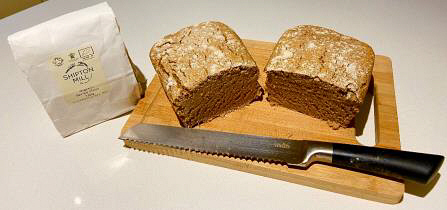

|
 Yeast-raised barley bread is known from ancient times, but, it being, presumably, a commonplace product there was no need to write down any receipts. It is mentioned in passing in Robert May 1660; "a slice of barley bread hot out of the oven" and in 'The Cook and Housekeeper's Dictionary' Mary Eaton (Eaton 1822) says that "In cases of gout ... The constant use of barley bread is recommended."  "It is super crumbly as a dough - my more like a dark rye loaf in texture. Very nice with some cheese though!" Image: Alex Bray... The 'Oxford Journal' (Saturday 6 December 1755) tells us that "into the County of Cornwall, where it is common for the Poor to eat Barley Bread, which affords a very good Nourishment, and is used in some good Families." The fact that Barley Bread was a subsistence food is renforced by its frequent appearance in prison diets of the 19th Century. The 'Western Morning News' - Friday 01 March 1946 has; Present food situation recalls the dishes our grandparents. Before the repeal of the Corn Laws in 1846, white flour was very dear, and it was customary in West Cornwall to have tarts with the upper crust of wheaten flour, for appearance, and the bottom of barley, for economy. In those days bread was made with barm instead of yeast. When baking barley bread it was covered with a large cabbage leaf before putting in the oven, as barley bread required lot of baking, and the moist leaf prevented the outer crust from being burnt too hard.  Original Receipt from 'Southern Reporter' - Thursday 18 July 1918 Original Receipt from 'Southern Reporter' - Thursday 18 July 1918BARLEY BREAD.— Mix two pounds of barley flour with small teaspoonful salt. Rub one ounce of yeast smooth with a teacup full of tepid water, and pour it into the centre of the flour. Make into a light dough with more warm water, and set near the fire rise. When risen to twice its size, knead the dough well, then put it into two greased tins and let rise again for half an hour. Bake in a brisk oven. Two pounds of barley flour should make three pounds of bread.  Original Receipt from the Dublin 'Freeman's Journal' - Monday 31 December 1838 Original Receipt from the Dublin 'Freeman's Journal' - Monday 31 December 1838BARLEY BREAD. We have been requested by a friend to call the attention of our readers to the capabilities of fine barley flour, raised with yeast in the usual way, for producing bread of excellent quality and palatableness. This bread, which can be made at the rate of 5lbs. for a shilling, is represented to us as being much sweeter and more palatable than the common brown wheat bread, and as the price is so much less, and the supply of wheat flour promises to be so deficient, we have thought it our duty to mention the circumstance - Lancaster Guardian  |
|
MORE FROM Foods of England... Cookbooks ● Diary ● Index ● Magic Menu ● Random ● Really English? ● Timeline ● Donate ● English Service ● Food Map of England ● Lost Foods ● Accompaniments ● Biscuits ● Breads ● Cakes and Scones ● Cheeses ● Classic Meals ● Curry Dishes ● Dairy ● Drinks ● Egg Dishes ● Fish ● Fruit ● Fruits & Vegetables ● Game & Offal ● Meat & Meat Dishes ● Pastries and Pies ● Pot Meals ● Poultry ● Preserves & Jams ● Puddings & Sweets ● Sauces and Spicery ● Sausages ● Scones ● Soups ● Sweets and Toffee ● About ... ● Bookshop ● Email: [email protected] COPYRIGHT and ALL RIGHTS RESERVED: © Glyn Hughes 2022 BUILT WITH WHIMBERRY |